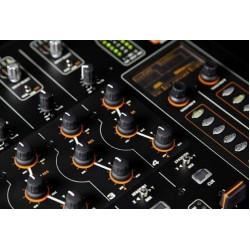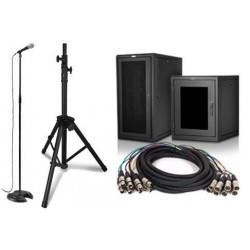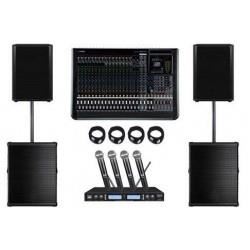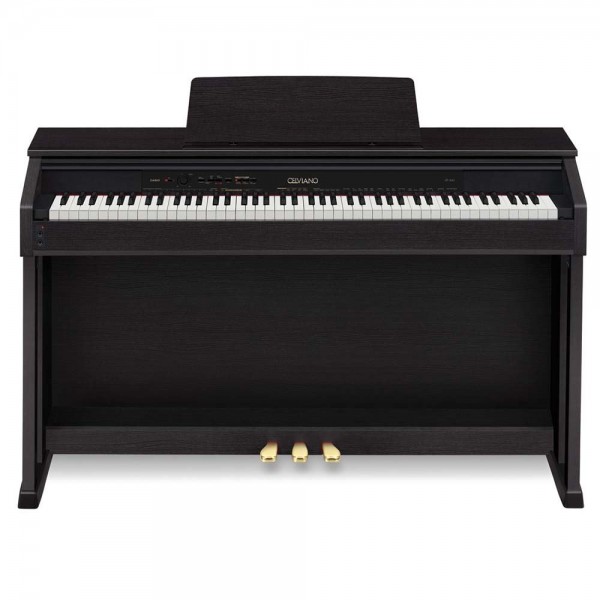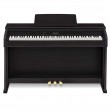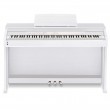Casio AP-460
Casio AP-460 Celviano Digital Piano
The pure feel of the piano. You will forget that you are playing a digital instrument, with its AiR sound production, authentic timbre and richly detailed string resonance reproduction. The lesson function „Concert Play“ allows to play the piano part with orchester accompaniment. This pleasure with the piano for purists culminates with the option of opening the AP-460‘s piano lid and just as with a grand piano enjoying a completely spatial sound experience
Features
New multi-dimensional AiR Sound Source
AiR is the acronym for “Acoustic and intelligent Resonator”, which is CASIO’s newly developed multi-dimensional sound production. This sound production and other innovations constitute the common core of the new digital piano technology. The result is the unprecedented, natural-sounding digital reproduction of a grand piano’s playing and sound properties.
256-note polyphony (max.)
Number of voices (tones) that a musical instrument can generate at the same time. Polyphony reflects a digital instrument’s capability. This is particularly significant when playing on an advanced level, using the pedals or using several timbres at the same time.
Scaled Hammer Action II
The II in Scaled Hammer Action II indicates that CASIO developed an improved keyboard. “Hammer action” means that the digital piano’s keyboard is weighted with small hammers in order to provide realistic touch sensitivity, just like that of a real grand piano. “Scaled” means that the weight of the keys decreases from the low to the high keys, just like with an acoustic instrument.
Tri-Sensor keyboard
CASIO's new keyboard action mechanism features three sensors per key that detect the intensity with which the key is struck to reproduce the response of a grand piano. This precise measurement also allows extremely sophisticated playing techniques at a high repetition speed.
Synthetic ebony and ivory keys
The fine keyboard design offers the same luxurious, haptic and optic features as genuine ebony and ivory. The carefully roughened surface texture prevents fingers from slipping, even when playing for a long time.
High resolution velocity
High Resolution Velocity is a new technology by CASIO, which is approved by the MIDI Manufacturers Association. Instead of 127 steps, this technology provides 16,000 steps of the keyboard’s touch response allowing to realise every nuance of grand pianos’ dynamics.
Variable piano lid
In the top of the line models, the piano features a real lid that can be opened or closed. This reinforces the impression of an acoustic piano.
Lid Simulation
The Lid Simulator simulates the different sound characteristics (brighter/duller) when playing with an open or closed piano lid. There are four simulation levels to choose from depending on personal taste: open, removed, half open or closed.
String Resonance
CASIO's unique string resonance system ensures precise simulation of the sympathetic and interacting piano strings for all 88 keys. The nuances generated by pressing the damper pedal ("damper resonance") are authentically replicated.
Key-off simulation
The Key-off Simulator ensures authentic end-of-note characteristics. Whether legato or staccato, the long time it takes for notes to fade when the keys are released softly is emulated with as much richness of nuance as the short fade-out time of notes when keys are released quickly.
Damper Resonance
The nuances generated by pressing the damper pedal are authentically replicated.
Hammer Response
The feel of an acoustic piano also comes from the delay between striking the key and the sounding of the string. The size and mass of the hammer head and the time that elapses until it hits the strings are directly linked to the pitch and striking intensity on the keyboard. This mechanical property of an acoustic instrument is reproduced by CASIO’s “Hammer Response” technology.
Audio recording function
The audio recording function enables the user to record in professional CD quality onto a USB storage medium or SD card (depending on the instrument). The recording can be burnt or played back on every common medium.
18 tones
The term tones indicates the different tones stored in the instrument.
60 songs
Pieces of music stored in the instrument. They can be used for practicing or just to listen to.
Metronome
The metronome keeps the beat in the preset time signature as an orientation guide for tempo.
Sequencer (2 tracks x 1 song)
A sequencer allows you to record your own ideas and compositions on the instrument (MIDI). It is possible to record and edit several songs with up to 17 tracks per song, depending on the sequencer’s size, creating complex arrangements.
Duet mode
This feature is designed, just like “Split”, to divide the keyboard into two zones. However, in this case, the range and the timbre are identical. This feature allows two musicians to play a piano duet or to practice together on one instrument.
Layer
This function layers two timbres, such as soft piano sounds combined with bowed string instruments, perfectly suited for ballads as well as slow and romantic songs.
Split
Possibility of dividing the keyboard into two zones playing differing timbres, e. g. bass with your left hand and piano or vibraphone with your right hand when playing jazz or swing.
Reverb
Digital Effect that puts reverberation on the timbre.
Chorus
Digital effect used to double the timbre, making the sound more vibrant, broader and much livelier. This effect is used especially for digital piano or organ timbres.
Brilliance
Digital effect that is used especially with piano timbres; the sound becomes brighter and more powerful (brilliance).
Scale function
Tuning based on different scales allows the user to play other sequences of semitones and whole tones, which, for example, enables him to play in old ecclesiastical modes.
Fine tune control
This feature allows the user to tune the keyboard to another instrument, such as an out of tune piano.
Transpose function
The transpose function shifts the scale on the keyboard by a set interval, e.g. so that an F would be played with the C-key.
Octave shift
This setting shifts the octaves on the keyboard to the more comfortable middle zone when playing pieces of music which require the musician to play on the very low or high zone of the keyboard.
Headphones (2x)
Possibility to connect standard headphones. When headphones are connected, no sound will be released through the instrument’s speakers.
3-pedal unit (built-in)
Classic pedal unit similar to most upright or grand pianos: 1x damper pedal, 1x sostenuto pedal and 1x soft pedal.
USB flash memory port (storage medium)
Port used to connect customary USB storage media to your instrument for the purpose of data transfer.
USB interface (PC)
Port for a USB cable to connect the instrument with a PC or Mac for the purpose of MIDI and/or data transfer.
Line OUT (L/Mono, R)
Audio output on line level to plug the instrument into other professional devices such as PA or mixer console.



